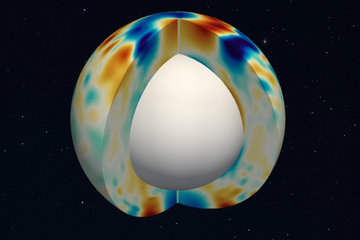All genres
1.
Journal Article
Determination of the SO/PHI-HRT wavefront degradation using multiple defocused images. Astronomy and Astrophysics 681, p. A58 (2024)
2.
Journal Article
Determination of the SO/PHI-HRT wavefront degradation using multiple defocused images. Astronomy and Astrophysics 681, p. A58 (2024)
3.
Journal Article
Synoptic maps from two viewpoints. Preparing for maps from SDO/HMI and SO/PHI data. Astronomy and Astrophysics 682, p. A108 (2024)
4.
Journal Article
A first rapid synoptic magnetic field map using SDO/HMI and SO/PHI data. Astronomy and Astrophysics 681, p. A59 (2024)
5.
Journal Article
Intensity contrast of solar network and faculae close to the solar limb, observed from two vantage points. Astronomy and Astrophysics 678, p. A163 (2023)
6.
Journal Article
Intensity contrast of solar network and faculae close to the solar limb, observed from two vantage points. ASTRONOMY & ASTROPHYSICS (2023)
7.
Journal Article
Spectropolarimetric investigation of magnetohydrodynamic wave modes in the photosphere: First results from PHI on board Solar Orbiter. Astronomy and Astrophysics 674, p. A109 (2023)
8.
Journal Article
Wavefront error of PHI/HRT on Solar Orbiter at various heliocentric distances. Astronomy and Astrophysics 675, p. A61 (2023)
9.
Journal Article
Coronal voids and their magnetic nature. Astronomy and Astrophysics 678, p. A196 (2023)
10.
Journal Article
The ratio of horizontal to vertical displacement in solar oscillations estimated from combined SO/PHI and SDO/HMI observations. Astronomy and Astrophysics 673, p. A84 (2023)
11.
Journal Article
Magnetic fields inferred by Solar Orbiter: A comparison between SO/PHI-HRT and SDO/HMI. Astronomy and Astrophysics 673, p. A31 (2023)
12.
Journal Article
Stereoscopic disambiguation of vector magnetograms: first applications to SO/PHI-HRT data. Astronomy and Astrophysics 677, p. A25 (2023)
13.
Journal Article
Direct assessment of SDO/HMI helioseismology of active regions on the Sun's far side using SO/PHI magnetograms. Astronomy and Astrophysics 674, p. A183 (2023)
14.
Journal Article
The magnetic drivers of campfires seen by the Polarimetric and Helioseismic Imager (PHI) on Solar Orbiter. Astronomy and Astrophysics 660, p. A143 (2022)
15.
Journal Article
Using birefringent elements and imaging Michelsons for the calibration of high-precision planet-finding spectrographs. Astronomy and Astrophysics 662, p. A119 (2022)
16.
Journal Article
Autonomous on-board data processing and instrument calibration software for the Polarimetric and Helioseismic Imager on-board the Solar Orbiter mission. Journal of Astronomical Telescope Instruments and Systems 6 (4), 048004 (2020)
17.
Journal Article
Characterizing the spatial pattern of solar supergranulation using the bispectrum. Astronomy and Astrophysics 635, A181 (2020)
18.
Journal Article
An improved multi-ridge fitting method for ring-diagram helioseismic analysis. Astronomy and Astrophysics 633, A109 (2020)
19.
Journal Article
Exploring the latitude and depth dependence of solar Rossby waves using ring-diagram analysis. Astronomy and Astrophysics 634, A44 (2020)
20.
Journal Article
Estimating the nonstructural component of the helioseismic surface term using hydrodynamic simulations. Astronomy and Astrophysics 638, A51 (2020)











